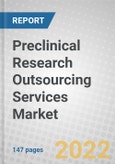This report identifies the global preclinical research outsourcing services market, along with all major global preclinical CRO companies. The total preclinical research outsourcing services market is segmented globally and by geographic regions. The service areas provided by preclinical CROs are extensively covered as well. The report offers a detailed examination of preclinical services, analyzes market trends for preclinical research outsourcing services with data from 2020, estimates from 2021, and projections of CAGR through 2026 (forecast period 2021–2026). This report provides a comprehensive analysis of the top preclinical CROs and evolving roles in the preclinical outsourcing services. CRO expertise within certain therapeutic areas and experience with new and adaptive study design protocols can reduce costs and study duration. CROs are expected to continue to play an increasing role in many aspects of the preclinical and clinical trial process. Strong demand for CROs leads to heightened market assessments and many blockbuster mergers and acquisitions (M&As). M&A activity has led to a few companies to develop proficiency across many areas of the clinical trial process. However, niche players still play crucial roles. This report analyzes emerging trends and changing dynamics within the preclinical research outsourcing services industry.
Report Includes
- 24 data tables and 12 additional tables
- An up-to-date review and analysis of the global markets for preclinical research outsourcing services
- Analyses of the global market trends, with historic revenue (sales) data from 2019-2021, estimates for 2022, and projections of compound annual growth rates (CAGRs) through 2026
- Evaluation and forecast the global market size for preclinical research outsourcing services, projected growth trends, and corresponding market share analysis by functional services and geographic region
- In-depth information (facts and figures) concerning market drivers, market deterrents and other macroeconomic forces affecting the current and future market demand
- Identification of companies best positioned to meet this demand owing to their proprietary technologies, mergers and acquisitions, joint ventures and other strategic alliances
- Regulatory structure for preclinical research studies in the pharmaceuticals industry, marketed and pipeline products, pricing and reimbursement structure, and major developments influencing the progress of this market
- Detailed analysis on the strength, weakness, and opportunities of the prominent players operating in the global preclinical research outsourcing services market
- Insight into recent industry structure, current competitive scenario, increasing investments on R&D activities, current pharma/CRO contracts and company value share analysis based on their segmental revenues
- Company profiles of major players, including Eurofins Scientific, IQVIA, Labcorp, SGS SA, and Thermo Fisher
Table of Contents
Chapter 1 Introduction
Chapter 3 Market Dynamics
Chapter 4 Impact of Covid-19
Chapter 5 Global Market Overview
Chapter 6 Regulatory Landscape
Chapter 7 Market Analysis by Functional Service
Chapter 8 Market Analysis by Region
Chapter 9 Competitive Landscape
Chapter 10 Analysis of Market Opportunities
Chapter 11 Company Profiles
List of Tables
List of Figures
Executive Summary
Outsourcing preclinical services of the drug discovery and development process offers the pharmaceutical industry a wide range of opportunities to develop and commercialize, innovative methods and technologies. Outsourcing is an attractive approach for investigations that are too complex, too expensive, and too lengthy otherwise to be conducted in-house. In previous times, outsourcing was seen as a short-term strategy for demand realization. Now, it is considered as the key lever for the core competencies to increase performance in pharmaceutical research. Outsourcing can positively impact research performance because it lowers the cost and time associated with new innovations.There are two ways to outsource services:
- Full vertical integration, which maximizes operations conducted in-house.
- Virtual operations, which relates to full outsourcing and where all operations are methodically outsourced to third parties.
The outsourcing service providers/CROs market continues to exhibit significant growth, largely attributed to increased demand for services in clinical trials including preclinical research. The proliferation of therapies for orphan drugs and precision-based medicines, preclinical and clinical trials are becoming increasingly complex, which is driving demand for sophisticated outsourcing partners with expertise in preclinical services, disease registries, real world evidence, medical affairs and risk-based monitoring. Expanding service offerings and capabilities remain a predominant strategy among CROs.
The geographic distribution of clinical research is slowly shifting from developed nations to emerging countries in regions such as Central and Eastern Europe, Asia-Pacific and Latin America. Also, the greater disease difference among developing countries offers more diverse population samples, particularly for rare disease studies.
IQVIA Inc. , Labcorp PPD Inc. , Syneos Health, Charles River Laboratories International Inc. and Medpace are the CRO industry’s dominant players. Mergers and acquisitions among these and other large companies in the preclinical research outsourcing continues at an extraordinary pace, driven by high valuations and the increasing need to become complete service providers. Current pharmaceutical R&D spending is driven by precision-based medicines and immunotherapies for smaller populations, genetic therapies for oncology, rare disease treatment and generally more demanding and complex protocols for drug development.
The preclinical research environment continues to be tied to exorbitant costs as complex therapies requiring larger and more diverse samples increases the time required and geographies involved in conducting a typical trials. To rein in costs and shorten development timelines, pharmaceutical and biopharma firms are increasingly outsourcing services to CROs. In addition to complex therapies, combination regimens increase timelines and difficulties. Today, CROs operate more efficiently and improve quality and timeliness for sponsors despite the increasing complexities of studies. This is bolstering CRO penetration in all stages of development.
Table Information
| Report Attribute | Details |
|---|---|
| No. of Pages | 147 |
| Published | May 2022 |
| Forecast Period | 2021 - 2026 |
| Estimated Market Value ( USD | $ 5.6 Billion |
| Forecasted Market Value ( USD | $ 8.3 Billion |
| Compound Annual Growth Rate | 8.1% |
| Regions Covered | Global |









